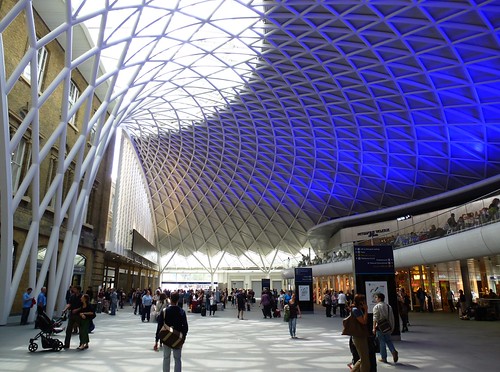A resurgent King’s Cross has left behind it’s long-held reputation for tatty and squalid under-achievement and has instead become a beacon for urban regeneration.

A couple of weekends ago I travelled up to York for a reunion with some old friends. Taking the train from King’s Cross, I was very impressed with the newly refurbished station, which opened last year in time for the Olympics. The impressive King’s Cross Square – the final piece in the jigsaw – in front of the station opened a few days after my journey.
London’s Refreshing New Approach
In many ways King’s Cross recent history represents London’s changing approach to its best assets, which I suspect owes much to the re-introduction of a central London government in the form of the mayor and the GLA well over a decade ago, and was given a serious shot in the arm when the Olympic bid was won in 2005. In the past, all too often London would fail to capitalise on its best features – the underuse of the River Thames and St Paul’s Cathedral being surrounded by ugly, grey 1960’s buildings spring to mind as examples. Now both are once again rightly focal points in the City’s landscape. Similarly King’s Cross – home to the British Library and featuring not one, but two magnificent Victorian stations, located by the Regent’s Canal – has long been an area with rich with potential, but short on realisation. Instead, over the years it’s been allowed to fall into disrepair – during the course of my lifetime, I’ve always thought of it at best as a tatty party of London, and at worst downright seedy with it’s notorious red light district. Let’s not forget that – incredibly – St Pancras Station narrowly escaped demolition in the 1960’s thanks to Poet Laureate St John Betjeman’s campaigning. And the Grand Midland Hotel – bomb-damaged and only partially repaired after the Second World War – was criminally used as offices for British Rail for many years, before falling into disuse. What a waste!
King’s Cross jettisons its tired reputation to become a beacon
However my journey through King’s Cross last month showed me at first hand that the area – once a byword for squalid decline and missed opportunity – is now making use of its assets and has quickly become a beacon of urban regeneration.
Redevelopment of the Stations critical to urban regeneration
Building HS1 and moving the Eurostar Terminal to St Pancras kick started the process back in 2007. And the Olympics acted as a catalyst – with HS1 being used to for Olympic Javelin service, a high speed 7 minute shuttle between St Pancras International in Central London and the Olympic Park in Stratford. As the gateway to London for many European travellers coming from Paris, Brussels and beyond, it was essential that the redeveloped St Pancras packed a punch and made an impressive first impression to new arrivals. And the refurbished station doesn’t disappoint, cleverly combing the beautifully restored Victorian features with state of the art facilities and amenities. The modern foyer extension providing an entrance on the east side of the station doesn’t detract from the original building, but contrasts with it and enhances it. And The Grand Midland was finally restored and re-opened as a hotel – rechristened the The St Pancras Renaissance Hotel
And King’s Cross Station has now followed suit – with a £500 million restoration and refurbishment. Like St Pancras, they’ve built a modern extension to the side of the original building – this time a semi-circular departures concourse which opened last year in time for the Olympics (replacing the tatty and cramped 1972 extension). Once again it feels modern and fresh, without compromising any of the original Victorian architecture. And it even has room for the quirky tribute to Harry Potter’s famous Platform 9 3/4, with the luggage trolley magically disappearing into the wall.
Massive £2.2 Billion investment
And beyond the redevelopment of the stations and hotel, the area as a whole has apparently attracted a staggering £2.2 billion of private investment to re-develop 60 acres into offices and shops and couple of thousand new homes. Just over 4 minutes walk from the stations, the “urban oasis” Regent Quarter now provides state of the art residential, retail and office accommodation, along with hotels, restaurants and cafes. A far cry from the rundown King’s Cross of the 20th Century.
Opportunity for Businesses?
Office space in King’s Cross ranges from medium to top quality – but – at £40 per ft2, rents remain at the lower end of the London Office rental market. For businesses looking to locate in a smart, up-and-coming part of London with great transport connections to Europe, as well as the North, King’s Cross represents an excellent choice.
This is just one piece of the puzzle. We’re constantly answering the most important office search questions. See what else we’ve covered and what’s coming next.

Renting office space in Outer London – A Beginner’s Guide
Our Beginner's Guide walks you through renting office space in Outer London. Pros & cons, plus key info to make an educated decision.
Read MoreFor more essential tips and advice, have a look at The Knowledge - and for answers to your questions about London office space, check out our FAQs.
Ben has been designing, building and promoting websites for over 20 years. He is responsible for all of Find a London Office’s online activity, which broadly falls into 2 areas: gaining new clients and retaining existing ones.
